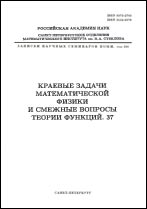|
|
Zapiski Nauchnykh Seminarov LOMI, 1985, Volume 144, Pages 136–145
(Mi znsl5306)
|
 |
|
 |
This article is cited in 3 scientific papers (total in 3 papers)
A parametrized modulus problem for a family of several classes of curves
A. Yu. Solynin
Abstract:
Let , where $\bar{ \mathbb{C} }^\prime=\bar{ \mathbb{C} }\setminus\{A\cup B\}$ and $A=\{a_1,\dots,a_n\}$ и $B=\{b_1,\dots,b_m\}$ are systems of distinguished points, and let $H$ be a family of homotopic classes $H_i$, $i=1,\dots,j+m$, of closed Jordan curves in $\bar{ \mathbb{C} }$, where the classes $H_{j+\ell}$, $\ell=1,\dots,m$, consist of curves that are homotopic to a point curve in $b_\ell$. Let $\alpha=\{\alpha_1,\dots,\alpha_{j+m}\}$ be a system of positive numbers. By $P=P(\alpha,A,B)$ we denote the extremal-metric problem for the family $H$ and the numbers $\alpha$: for the modulus $M=M(\alpha,A,B)$ of this problem we have the equality
$$
M=\sum^{j+m}_{i=1}\alpha^2_i M(D_i^\ast),
$$
Where $D^\ast=\{D_1^\ast,\dots,D^\ast_{j+m}\}$ is a system of domains realizinga maximum for the indicated sum in the family of all systems $D=\{D_1,\dots,D_{j+m}\}$ of domains, associated with the family $H$ (by $M(D_1)$) we denote the modulus of the domain $D_i$, associated with the class $H_i$). In the present paper we investigate the manner in which $M=M(\alpha,A,B)$ and the moduli $M(D_i^\ast)$ depend on the parameters $\alpha_i$, $a_k$, $b_\ell$; moreover, we consider the conditions under which some of the doubly connected domains $D_i^\ast$, $i=1,\dots,j$, from the system $D^\ast$ turn out to be degenerate (Theorems 1–3). In particular, one obtains an expression for the gradient of the function $M$, as function of the parameter $a=a_k$ (Theorem 4). One gives some applications of the obtained results (Theorem 5).
Citation:
A. Yu. Solynin, “A parametrized modulus problem for a family of several classes of curves”, Analytical theory of numbers and theory of functions. Part 6, Zap. Nauchn. Sem. LOMI, 144, "Nauka", Leningrad. Otdel., Leningrad, 1985, 136–145
Linking options:
https://www.mathnet.ru/eng/znsl5306 https://www.mathnet.ru/eng/znsl/v144/p136
|

| Statistics & downloads: |
| Abstract page: | 121 | | Full-text PDF : | 58 |
|




 Contact us:
Contact us: Terms of Use
Terms of Use
 Registration to the website
Registration to the website Logotypes
Logotypes








 Citation in format
Citation in format 
